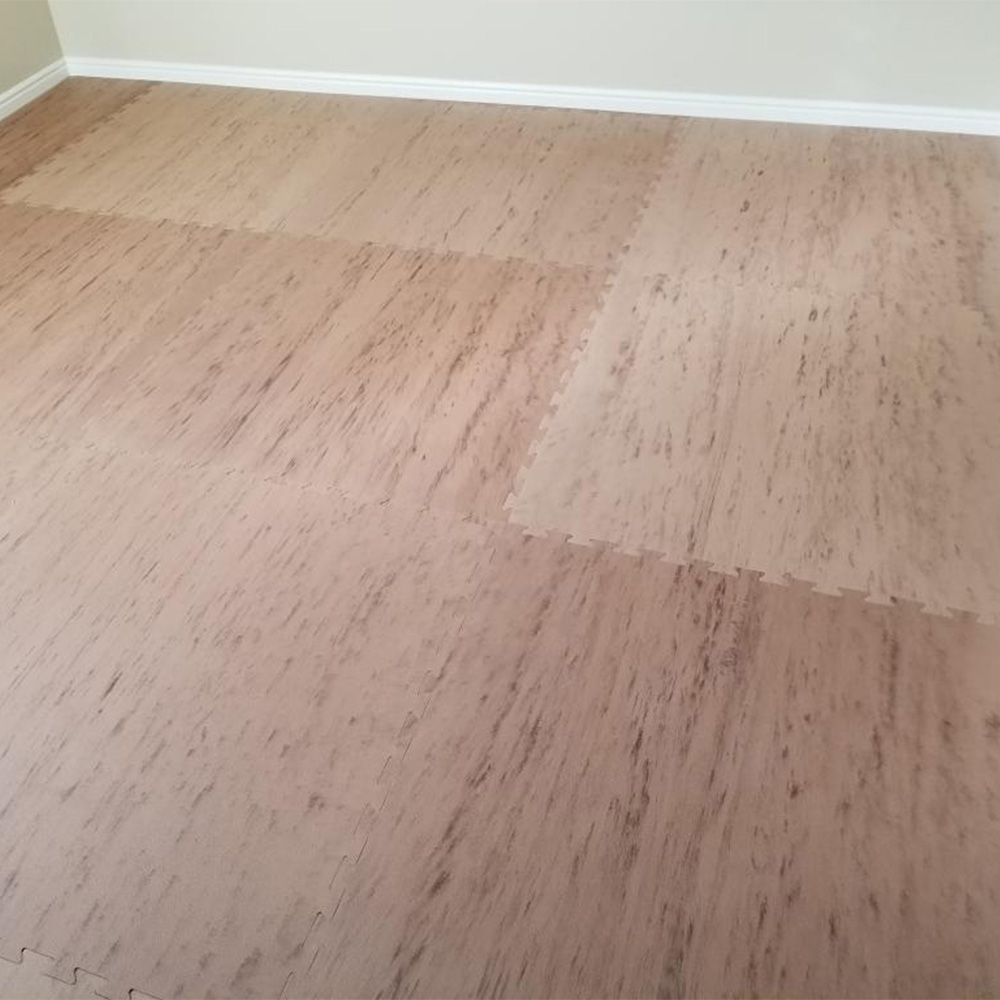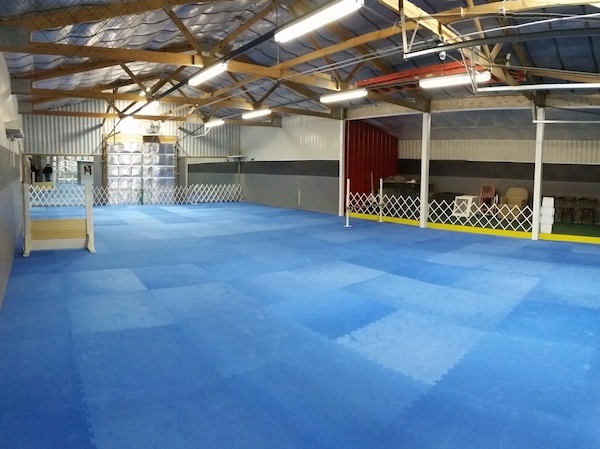Dog flooring is available in different models that provide help with specific use cases for the animals and trainers. Whether you have involvement in indoor dog training, agility, daycare, or obedience, Greatmats carries multiple types of the best flooring for dogs. We can help you with DIY projects for a dog run at home or with ideas for making better use of your facility’s space.
Article Library












Video Library












Ideas Before You Buy Dog Flooring
Tips & considerations for purchasing dog flooring:
The following blogs offer tips on what aspects to look for in dog agility floor mats and matting before making a purchase. Wherever you plan to use this flooring, these are all important things to learn before making your final decision.- Find out about safety, installation, and cleaning procedures for Greatmats interlocking dog agility mats. Learn More: Interlocking Foam Mats for Dogs - Safety, Installation & Cleaning
- Find out what you should know about artificial turf before purchasing dog agility turf. Learn More: How to Choose Dog Agility Turf
- Learn about a great resource for the best nonslip rubber matting for dog crates that works perfectly in a small or large crate. Learn More: Where Do You Find Non-Slip Rubber Matting for Dog Cages?
Top 10 Questions About Dog Flooring
Below are the most popular questions we've received about ground protection solutions. Click the question to get a detailed answer and explanation on these topics.- What Makes the Best Dog Crate Floor Protection Mats? Using mats inside dog crates can protect the floor underneath the crate and can deliver more comfort for the animal. Rubber or foam materials are the best to place underneath a crate for a dog.
- What Are the Top 5 Floors for Dog Kennels? Dog kennel flooring should be easy to clean while remaining durable when the animal wants to scratch at the flooring. Some of the best materials Greatmats offers as dog flooring in kennels include foam tiles, rubber tiles, artificial turf, and raised plastic tiles.
- Are Rubber Mats, Foam Mats, or Turf Better for Dog Flooring? Rubber mats provide the highest level of durability for use around dogs, while foam mats have extra cushioning that makes the space more comfortable for playing and resting. Artificial turf is both durable and comfortable, and some people like the way it resembles natural grass.
- What Are the Top 5 Floors for Dog Daycare? Daycare facilities for dogs need to install durable types of flooring that keep the animals safe while also being easy to clean. Rubber will last a long time while providing slip resistance, and foam tiles deliver cushioning and ease of installation. Artificial turf is great for large play areas.
- What Dog Flooring Works Best for 10x10 Dog Kennels? To simplify covering the floor of a dog kennel that measures 10x10 feet, Greatmats offers a 10x10 foot kit of rubber flooring made for a horse stall that doubles for dog kennels. You also could purchase easy-to-cut tiles, such as foam or PVC plastic tiles, to simplify creating the perfect coverage size.
- How Do I Protect My Older Dog From Slipping on Hardwood Floors? Excitable dogs who are running or jumping on a hardwood floor could fall and injure themselves, especially elderly dogs. To provide a greater level of slip resistance for older dogs, consider installing interlocking foam mats, thin rubber mats, or interlocking carpet tiles.
- What Are the Top 5 Floors for Dog Training? Flooring inside a canine training facility needs to be durable enough to stand up to dog nails while also creating a cushioned, slip-resistant space. Rubber rolls, artificial grass rolls, and foam tiles all can deliver these benefits.
- How Do You Install Interlocking Foam Mats for Dogs? Interlocking foam puzzle mats are great for dogs because they provide cushioning and anti-slip properties. Installation is a breeze, as the puzzle-style edges on the tiles pop together with very little effort, and it’s easy to cut the tiles to fit a tight space.
- How Do You Clean Dog Daycare Flooring? When cleaning flooring for a dog daycare facility, you want to disinfect the area without causing damage to the materials and without potentially harming puppies. Typically, you should avoid cleaners with bleach, ammonia, chlorine, and similar compounds.
- What Are the Top 5 Floors for Animal Shelters? Animal shelters need floors that can stand up to constant use from dogs while also delivering a great value. Materials like foam tiles, rubber rolls, and artificial turf rolls can cover a large space without breaking the budget.
Best Dog Flooring Products
Dog Agility Interlocking Tiles
Our non-slip Dog Agility Interlocking Tiles measure 1x1 meter, meaning you can cover a large space for a reasonable price.
Rolled Rubber Sport Regrind, 3/8 Inches
With our 3/8-inch Rolled Rubber Sport Regrind, you can create a safe space for dogs to play and rest while receiving a sharp-looking confetti color fleck design.
Rolled Rubber Sport Regrind, 1/4 Inches
To save money on your Rolled Rubber Sport Regrind, we offer this confetti color fleck design in a roll that measures 1/4 inch in thickness.
Geneva Black Rubber Flooring Roll, 1/4 Inches
Our inexpensive Geneva Black Rubber Flooring Roll only measures 1/4 inches in thickness, but it’s still a highly durable material that provides great value well into the future.
Geneva Black Rubber Flooring Roll, 3/8 Inches
At 3/8 inches in thickness, you receive a bit more durability with our Geneva Black Rubber Flooring Roll than is available with thinner materials, but it still has a reasonable cost per square foot.
Dog Flooring Customer Installations
Sara Carson Testimonial
To work on dog tricks while at home, professional dog trainer Sara Carson installed 170 square feet of our foam tiles to take advantage of their cushioning and longevity.
Tricks: Premium Foam Kids and Gym Mats
Association of Professional Dog Trainers
Rather than renting carpeting for its annual conference, the Association of Professional Dog Trainers decided to install our dog agility tiles to create a safer space for the animals that saved money over the long run.
Conferences: Interlocking Dog Agility Mats
The Agility Facility
At The Agility Facility, installing durable flooring that protected the dogs in training was vitally important, leading the facility to select our foam dog agility tiles.
Agility: Interlocking Dog Agility Mats
DogLoversDays
When traveling to set up lure courses across North America, the DogLoversDays business needed an easily portable flooring option that was safe for dogs, and it selected Greatmats’ foam tiles.
Lure Course: Interlocking Dog Agility Mats
Babinski Foundation Rehab and Training
To help train and rehabilitate dogs and puppies that need a second chance at finding a forever home, the Babinski Foundation Rehab and Training facility installed our rubber rolls as a cost-effective, slip-resistant option.
Shelter: Rolled Rubber Sport Regrind
Rio Gran Boarding and Daycare
After purchasing an existing doggy daycare facility, the owners of the Rio Gran Boarding and Daycare wanted to upgrade the dog flooring areas, selecting our rubber rolls after a significant amount of research.
Daycare and Boarding: Geneva Rubber Flooring Roll
Fido’s Nosework
Although the scent work training occurring at Fido’s Nosework doesn’t involve dogs running, it still requires a durable and safe flooring that looks great, which the facility receives with our rubber mats.
Nosework: 4x6 Rubber Floor Mats
Neuman K9 Academy
After moving the Neuman K9 Academy to a rural property, the owners wanted to transform an existing shed into a safe training area, which became possible after installing our foam agility mats.
Boot Camp: Interlocking Dog Agility Mats
Dog Flooring Installation & Maintenance Videos
Comparing Dog Agility Flooring Options - Foam and Rubber
Cloud Nine Training School on Greatmats Dog Agility Mats Interlocking Tiles
HVD Professional Kennel Matting for Dogs & Other Animals















